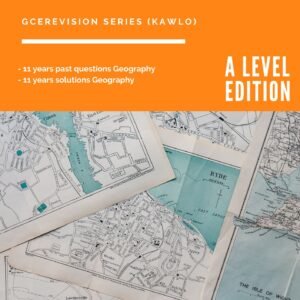SECTION A
MAP WORK
1. Study the Map Extract of Penrith and Keswick (1:50.000) provided and answer the questions that follow:
(a) Draw a sketch map of the portion between northing 21 and 28 to the same scale as the original and
on it insert and name the following:
(i) River Leith and show its direction of flow with an arrow.
(ii) The motorway
(iii) Railway
(iv) Decoy Pond
(v) An area covered by a National Park
(12 marks)
(b) In your answer booklet, calculate the distance along the Roman Road from 570289 to the
Roundabout in square 5229 (4 marks)
(c) (i) Using Map evidence only describe the functions of Penrith (8 marks)
(ii) Describe the distribution of vegetation in the whole map. (6 marks)
(Total = 30 marks)
SECTION B
PHYSICAL GEOGRAPHY
2. (a) By the use of a table, name any FIVE (5) elements of weather and state their units of
• measurements.
(5 marks)
(b) Study the following landforms:
Ox-bow Lake, rock pedestal, cirque, sand spit, stalagmite
Choose ONE erosional and ONE depositional feature and with the aid of diagrams, describe
the processes of their formation. (9 marks)
(c) State THREE (3) ways by which plants in the tropical grasslands are adapted to their
environment. (6 marks)
(Total = 20 marks)
3. Study the pie chart below (Fig. 1) which shows the contribution of greenhouse gases (percentage)
to global warming.

(a) Name the gas labelled A and state three of its sources. (4 marks)
(b) Describe any two of the following:
(i) The effects of latitude on temperature.
(ii) Four proofs that the earth is spherical in shape
(iii) The effects of earth’s rotation
(iv) Occurrence of hot deserts
(10 marks)
(c) (i) What is the hydrological cycle?
(ii) With the use of a table, arrange the following components of the hydrological cycle under the headings STORES, FLOWS and OUTPUT: Transpiration, groundwater, evaporation,
percolation, interception, infiltration. (6 marks)
(Total = 20 marks)
SECTION C
HUMAN GEOGRAPHY
4. (a) . On the outline world map provided, locate and name
(i) One area of low population density
(ii) A major fishing ground in the northern hemisphere
(iii) An area of high industrial concentration
(iv) One region with Newly Industrializing Countries (NICs)
(v) An area with a high potential of HEP
(b) (i) Define the term International Trade.
(ii) State and explain FOUR (4) measures used to protect domestic trade. (10 marks)
(2 marks) (8 marks)
(Total = 20 marks)
5. (a) Study carefully the diagram below (Fig. 2) and answer the • questions that follow:

(i) Give a name to the diagram above? (1 mark)
(ii) Name the four stages labelled I, II, III and IV shown on the diagram of a country found at each stage and give ONE example
(4 marks)
(iii) State TWO demographic characteristics of STAGE III.(2 marks)
(b) Explain the emergence of the Newly Industrialised Countries.(8 marks)
(c) Briefly describe five possible causes of air pollution.(5 marks)
(Total = 20 marks)
SECTION D
CAMEROON GEOGRAPHY
6. (a) On the outline map of Cameroon provided, locate and name
(i) The Adamawa Highland
(ii) The coastal lowlands
(iii) An area of rain forest
(iv) River Sanaga
(v) The towns of Yaounde and Douala Add a key (7 marks)
(b) Give reasons for the low population density in the Adamawa Region. (6 marks)
(c) What are the problems facing plantation agriculture in Cameroon? (7 marks)
(Total =20 marks)
7. (a) (i) With the aid of a sketch map, locate one industrial region you have studied in Cameroon.
(4 marks)
(ii) Why are manufacturing industries not well developed in Cameroon? (6 marks)
(b) Suggest FOUR possible ways in which the over exploitation of fish resources in Cameroon
can be controlled. (4 marks)
(c) What are the likely economic benefits of the recent developments in the mining sector in
Cameroon? (6 marks)
(Total =20 marks)















Debra engowei
March 3, 2021
Thanks so much it help me now